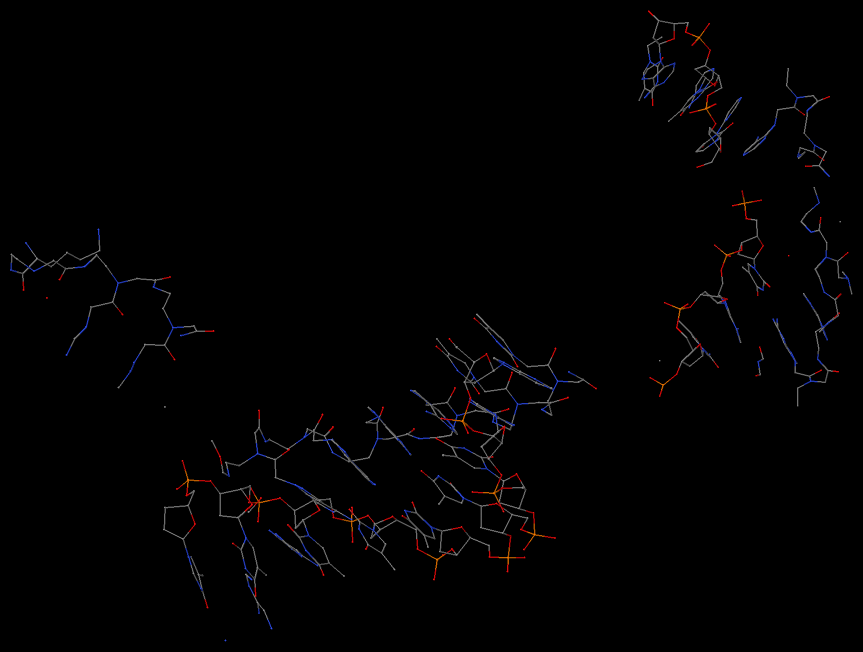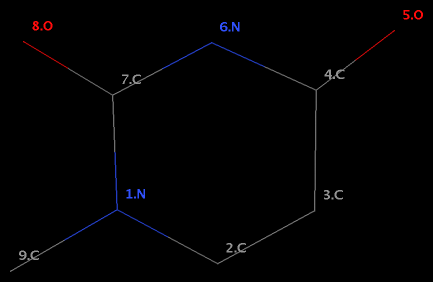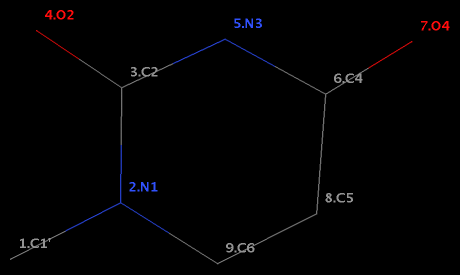Hi Arnab,
Thanks for your follow up. I am impressed by your attention to the little "details" -- oftentimes, the small part counts a lot.
Therefore, I assume there must be more to the story.
You are absolutely right -- see below for details.
To add to my previous post, the sanity check clears out str221.pdb for 6CG/CG step which has Zp 1.93 but unassigned type. However, I don't know the check corresponding to "WC_info && WC_info[i + 1] /* WC geometry */". Therefore, this may be a part of the issue of not getting the right form.
From the two PDB files you attached, it is easy to verify that all bps are of standard Watson-Crick type. So there is no issue with sanity check on WC_info(i) and WC_info(i + 1).
The real underlying reason for your observed discrepancy between str221 and str226 is as follows: to be on the safe side, 3DNA performs an additional check before assigning a dinucleotide step into A-, B- or TA-DNA form: there must be at least
two consecutive dinucleotide steps of the same type to avoid any single isolated (mostly spurious) "transition" step.
Take your
str221.pdb as an example,
step Xp Yp Zp XpH YpH ZpH Form
1 GC/GC -4.05 9.12 -1.51 -1.02 8.24 -4.15
2 CG/CG -2.24 8.83 0.29 -1.71 8.83 0.32 B
3 GC/GC -4.06 9.10 -0.65 -6.93 8.67 2.77 B
4 CA/TG -3.22 9.18 0.30 -7.45 8.28 4.02
5 AC/GT -3.17 9.21 1.03 -5.69 9.14 1.49
6 CG/CG -3.38 8.33 1.93 -7.49 8.45 1.33
7 GT/AC -3.58 8.97 0.80 -7.40 8.81 1.83
8 TG/CA -4.26 8.76 -0.67 -9.08 6.51 5.89
9 GC/GC -2.30 8.70 -0.08 -0.73 8.70 0.21 B
10 CG/CG -3.74 9.22 -0.75 -7.66 8.74 2.97 B
11 GC/GC -2.90 9.03 0.30 -5.61 8.55 2.92 B
According to the criteria detailed in my previous reply, step
6 CG/CG is indeed classified as A-DNA, since its Zp (1.93) > 1.5 Å. However, each of its neighbors -- 5 AC/GT and 7 GT/AC -- has a Zp < 1.5 Å, so neither is in A-form. Thus, 6 CG/CG is downgraded as unclassified. Note that without this additional check, step
4 CA/TG would have been taken as TA-DNA [Zp(h) = 4.02 > 4.0 Å].
With the above note, one can see easily why step 6 CG/CG in
str226 is classified as A-DNA -- it's simply because its neighbor 5 AC/GT is also A-DNA.
step Xp Yp Zp XpH YpH ZpH Form
1 GC/GC -4.37 8.77 -1.05 -4.95 8.83 -0.22 B
2 CG/CG -2.56 8.63 0.13 -2.38 8.49 1.55 B
3 GC/GC -3.74 9.12 -0.62 -4.46 9.06 -1.34 B
4 CA/TG -2.64 9.32 0.91 -6.75 7.91 5.00
5 AC/GT -3.16 9.32 1.56 -7.39 9.41 0.91 A
6 CG/CG -3.07 8.71 2.09 -7.45 8.73 1.93 A
7 GT/AC -3.49 9.02 0.43 -6.64 8.97 1.09 B
8 TG/CA -3.83 9.27 -0.68 -7.64 9.09 1.94 B
9 GC/GC -2.69 8.96 0.34 -2.36 8.95 0.55 B
10 CG/CG -4.15 8.96 -0.57 -7.70 8.62 2.56 B
11 GC/GC -3.43 8.71 1.58 -6.69 8.70 1.66
I may refine the criteria used for dinucleotide classification in future release of 3DNA, and I welcome your feedback. For your analysis of MD simulation trajectories, I'd suggest that you check directly the raw data (Xp, Yp, Zp, XpH, YpH, ZpH etc).
HTH,
Xiang-Jun





